Universal Salt Iodization (USI) - FTP Directory Listing
Universal Salt Iodization (USI) - FTP Directory Listing
Universal Salt Iodization (USI) - FTP Directory Listing
- No tags were found...
You also want an ePaper? Increase the reach of your titles
YUMPU automatically turns print PDFs into web optimized ePapers that Google loves.
www.unsystem.org/scn 3EditorialEliminating Iodine Deficiency: Learning from an Untold Public Health Success StoryFeaturesA major achievement in public health has been quietly unfolding over the past two decades. This specialissue of SCN News attempts to document the evolution of this remarkable story in the words of some of theindividuals who made it happen through the organizations and sectors that they represent. As Gautam pointsout: A unique combination of enlightened public policies, private industry action and civic sector commitmenthas led to exceptional global progress towards iodizing all edible salt and thereby protecting the world’spopulation against iodine deficiency disorders (IDD). There is no other initiative that has drawn together theproductive sector of society, the government sector, civic society and the general public in the manner thatiodine deficiency elimination has done.In 1990 less than one in five households in the world used iodized salt. Today 70% of households haveaccess to iodized salt. During this time, nearly US$ 400 million in external investment was matched by anestimated US$2 billion in salt industry investment. The tremendous global progress already made throughsalt iodization (<strong>USI</strong>) means that every year, 90 million newborn’s brains are protected against a significantloss of learning ability.The job is not finished, however. Although there has been significant success, more effort is required in orderto achieve complete coverage of iodized salt. This is especially important since the group not yet reached isamong the more marginalized section of the world’s population and in greatest need of protection againstIDD. Around the world every year, 40 million newborns are not yet protected against IDD. A disproportionatelylarge percentage of the rural poor do not have access to adequately- iodized salt. Thus the strategiesused until now to expand coverage of iodized salt are not necessarily appropriate to reach the population thatstill remains unprotected from iodine deficiency. New strategies will need to systematically identify the bottlenecksor constraints that impede universal iodization and address them. Refreshing the strategies needed toreach the last mile of <strong>USI</strong> coverage touches upon all the elements outlined in Hetzel’s model of IDDElimination and the directions to be taken can be found in the papers within this edition of SCN News.<strong>Salt</strong> iodization probably represents the first global experience in national fortification of a commodity toeliminate a public health problem. The experience of past years has shown that coordinated action by allsectors of society is the key to eliminating iodine deficiency in any given country: Governments pursuepolicies that protect newborns from preventable brain damage by supporting and sustaining salt iodization,and by monitoring progress; <strong>Salt</strong> industry and vendors produce and sell adequately iodized salt at a fair pricein cities and villages every day; and Civil society assists in public education about the dangers of iodinedeficiency, helping strengthen the public will to ensure that iodized salt remains available.Partnership continues to be the underlying thread that holds the push towards IDD elimination together. Theorganizations with which many of the authors are affiliated, are now part of an active global alliance, theNetwork for Sustained Elimination of Iodine Deficiency, dedicated to advocating and supporting the cause ofIDD elimination through their expertise, experience, programming and other resources.<strong>Salt</strong> iodization was conceived and developed as a vertical program. As programs become established andmature they need to be embedded within a broader health and nutrition framework as part of an essentialpackage of interventions to improve the health and well-being of people around the world. They are sustainedonly when ownership is fully assumed by all the sectors that collaborate to make it happen and ultimately theconsumer expects and demands it as a birthright that the State should ensure.While much research has been done in order to identify and prevent iodine deficiency, we still need thescientific community to continue refining advances in knowledge and technology on the etiology of thedeficiency, optimal impact of interventions and the monitoring framework for sustained elimination of theproblem. Sullivan et al. point out that effective monitoring and assessment of <strong>USI</strong> demands clarity on themethodology for measuring iodine nutrition status. Furthermore, policies continue to evolve and a clearerdefinition is needed to identify the different target groups that still need careful monitoring. From the supplyback to contents SCN NEWS # 35







